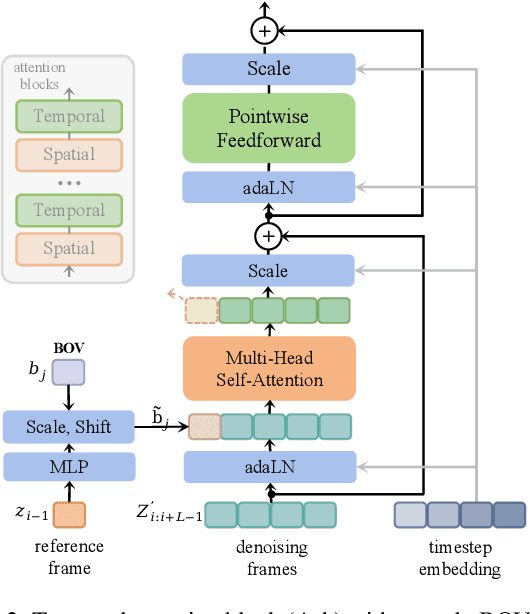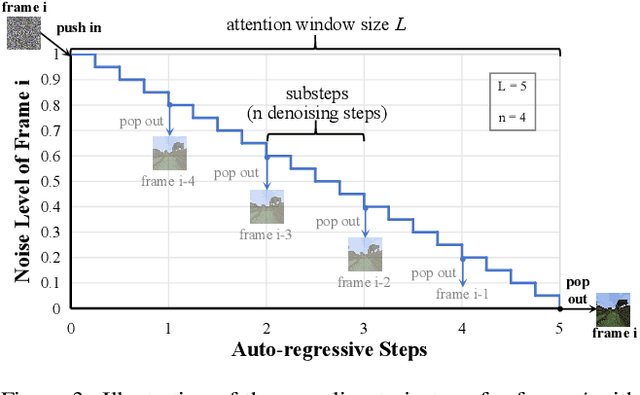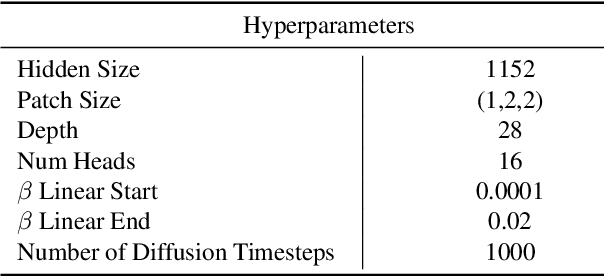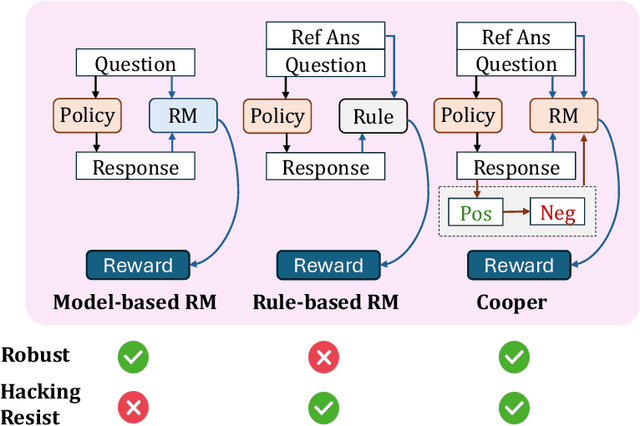Jun Xiao
AnyMS: Bottom-up Attention Decoupling for Layout-guided and Training-free Multi-subject Customization
Dec 29, 2025Abstract:Multi-subject customization aims to synthesize multiple user-specified subjects into a coherent image. To address issues such as subjects missing or conflicts, recent works incorporate layout guidance to provide explicit spatial constraints. However, existing methods still struggle to balance three critical objectives: text alignment, subject identity preservation, and layout control, while the reliance on additional training further limits their scalability and efficiency. In this paper, we present AnyMS, a novel training-free framework for layout-guided multi-subject customization. AnyMS leverages three input conditions: text prompt, subject images, and layout constraints, and introduces a bottom-up dual-level attention decoupling mechanism to harmonize their integration during generation. Specifically, global decoupling separates cross-attention between textual and visual conditions to ensure text alignment. Local decoupling confines each subject's attention to its designated area, which prevents subject conflicts and thus guarantees identity preservation and layout control. Moreover, AnyMS employs pre-trained image adapters to extract subject-specific features aligned with the diffusion model, removing the need for subject learning or adapter tuning. Extensive experiments demonstrate that AnyMS achieves state-of-the-art performance, supporting complex compositions and scaling to a larger number of subjects.
$\text{H}^2$em: Learning Hierarchical Hyperbolic Embeddings for Compositional Zero-Shot Learning
Dec 23, 2025Abstract:Compositional zero-shot learning (CZSL) aims to recognize unseen state-object compositions by generalizing from a training set of their primitives (state and object). Current methods often overlook the rich hierarchical structures, such as the semantic hierarchy of primitives (e.g., apple fruit) and the conceptual hierarchy between primitives and compositions (e.g, sliced apple apple). A few recent efforts have shown effectiveness in modeling these hierarchies through loss regularization within Euclidean space. In this paper, we argue that they fail to scale to the large-scale taxonomies required for real-world CZSL: the space's polynomial volume growth in flat geometry cannot match the exponential structure, impairing generalization capacity. To this end, we propose H2em, a new framework that learns Hierarchical Hyperbolic EMbeddings for CZSL. H2em leverages the unique properties of hyperbolic geometry, a space naturally suited for embedding tree-like structures with low distortion. However, a naive hyperbolic mapping may suffer from hierarchical collapse and poor fine-grained discrimination. We further design two learning objectives to structure this space: a Dual-Hierarchical Entailment Loss that uses hyperbolic entailment cones to enforce the predefined hierarchies, and a Discriminative Alignment Loss with hard negative mining to establish a large geodesic distance between semantically similar compositions. Furthermore, we devise Hyperbolic Cross-Modal Attention to realize instance-aware cross-modal infusion within hyperbolic geometry. Extensive ablations on three benchmarks demonstrate that H2em establishes a new state-of-the-art in both closed-world and open-world scenarios. Our codes will be released.
OmniMoGen: Unifying Human Motion Generation via Learning from Interleaved Text-Motion Instructions
Dec 22, 2025Abstract:Large language models (LLMs) have unified diverse linguistic tasks within a single framework, yet such unification remains unexplored in human motion generation. Existing methods are confined to isolated tasks, limiting flexibility for free-form and omni-objective generation. To address this, we propose OmniMoGen, a unified framework that enables versatile motion generation through interleaved text-motion instructions. Built upon a concise RVQ-VAE and transformer architecture, OmniMoGen supports end-to-end instruction-driven motion generation. We construct X2Mo, a large-scale dataset of over 137K interleaved text-motion instructions, and introduce AnyContext, a benchmark for evaluating interleaved motion generation. Experiments show that OmniMoGen achieves state-of-the-art performance on text-to-motion, motion editing, and AnyContext, exhibiting emerging capabilities such as compositional editing, self-reflective generation, and knowledge-informed generation. These results mark a step toward the next intelligent motion generation. Project Page: https://OmniMoGen.github.io/.
SegGraph: Leveraging Graphs of SAM Segments for Few-Shot 3D Part Segmentation
Dec 18, 2025Abstract:This work presents a novel framework for few-shot 3D part segmentation. Recent advances have demonstrated the significant potential of 2D foundation models for low-shot 3D part segmentation. However, it is still an open problem that how to effectively aggregate 2D knowledge from foundation models to 3D. Existing methods either ignore geometric structures for 3D feature learning or neglects the high-quality grouping clues from SAM, leading to under-segmentation and inconsistent part labels. We devise a novel SAM segment graph-based propagation method, named SegGraph, to explicitly learn geometric features encoded within SAM's segmentation masks. Our method encodes geometric features by modeling mutual overlap and adjacency between segments while preserving intra-segment semantic consistency. We construct a segment graph, conceptually similar to an atlas, where nodes represent segments and edges capture their spatial relationships (overlap/adjacency). Each node adaptively modulates 2D foundation model features, which are then propagated via a graph neural network to learn global geometric structures. To enforce intra-segment semantic consistency, we map segment features to 3D points with a novel view-direction-weighted fusion attenuating contributions from low-quality segments. Extensive experiments on PartNet-E demonstrate that our method outperforms all competing baselines by at least 6.9 percent mIoU. Further analysis reveals that SegGraph achieves particularly strong performance on small components and part boundaries, demonstrating its superior geometric understanding. The code is available at: https://github.com/YueyangHu2000/SegGraph.
FlowDC: Flow-Based Decoupling-Decay for Complex Image Editing
Dec 12, 2025Abstract:With the surge of pre-trained text-to-image flow matching models, text-based image editing performance has gained remarkable improvement, especially for \underline{simple editing} that only contains a single editing target. To satisfy the exploding editing requirements, the \underline{complex editing} which contains multiple editing targets has posed as a more challenging task. However, current complex editing solutions: single-round and multi-round editing are limited by long text following and cumulative inconsistency, respectively. Thus, they struggle to strike a balance between semantic alignment and source consistency. In this paper, we propose \textbf{FlowDC}, which decouples the complex editing into multiple sub-editing effects and superposes them in parallel during the editing process. Meanwhile, we observed that the velocity quantity that is orthogonal to the editing displacement harms the source structure preserving. Thus, we decompose the velocity and decay the orthogonal part for better source consistency. To evaluate the effectiveness of complex editing settings, we construct a complex editing benchmark: Complex-PIE-Bench. On two benchmarks, FlowDC shows superior results compared with existing methods. We also detail the ablations of our module designs.
Adaptive Begin-of-Video Tokens for Autoregressive Video Diffusion Models
Nov 15, 2025



Abstract:Recent advancements in diffusion-based video generation have produced impressive and high-fidelity short videos. To extend these successes to generate coherent long videos, most video diffusion models (VDMs) generate videos in an autoregressive manner, i.e., generating subsequent frames conditioned on previous ones. There are generally two primary paradigms: chunk-based extension and stream denoising. The former directly concatenates previous clean frames as conditioning, suffering from denoising latency and error accumulation. The latter maintains the denoising sequence with monotonically increasing noise levels. In each denoising iteration, one clean frame is produced while a new pure noise is simultaneously appended, enabling live-stream sampling. However, it struggles with fragile consistency and poor motion dynamics. In this paper, we propose Adaptive Begin-of-Video Tokens (ada-BOV) for autoregressive VDMs. The BOV tokens are special learnable embeddings on VDMs. They adaptively absorb denoised preceding frames via an adaptive-layer-norm-like modulation. This design preserves the global consistency while allowing for flexible conditioning in dynamic scenarios. To ensure the quality of local dynamics essential in modulating BOV tokens, we further propose a refinement strategy for stream denoising. It decouples the sampling trajectory length from the attention window size constraint, leading to improved local guidance and overall imaging quality. We also propose a disturbance-augmented training noise schedule, which balances the convergence speed with model robustness for the stream denoising. Extensive experiments demonstrate that our method achieves compelling qualitative and quantitative results across multiple metrics.
CoMo: Compositional Motion Customization for Text-to-Video Generation
Oct 27, 2025Abstract:While recent text-to-video models excel at generating diverse scenes, they struggle with precise motion control, particularly for complex, multi-subject motions. Although methods for single-motion customization have been developed to address this gap, they fail in compositional scenarios due to two primary challenges: motion-appearance entanglement and ineffective multi-motion blending. This paper introduces CoMo, a novel framework for $\textbf{compositional motion customization}$ in text-to-video generation, enabling the synthesis of multiple, distinct motions within a single video. CoMo addresses these issues through a two-phase approach. First, in the single-motion learning phase, a static-dynamic decoupled tuning paradigm disentangles motion from appearance to learn a motion-specific module. Second, in the multi-motion composition phase, a plug-and-play divide-and-merge strategy composes these learned motions without additional training by spatially isolating their influence during the denoising process. To facilitate research in this new domain, we also introduce a new benchmark and a novel evaluation metric designed to assess multi-motion fidelity and blending. Extensive experiments demonstrate that CoMo achieves state-of-the-art performance, significantly advancing the capabilities of controllable video generation. Our project page is at https://como6.github.io/.
Asynchronous Denoising Diffusion Models for Aligning Text-to-Image Generation
Oct 06, 2025Abstract:Diffusion models have achieved impressive results in generating high-quality images. Yet, they often struggle to faithfully align the generated images with the input prompts. This limitation arises from synchronous denoising, where all pixels simultaneously evolve from random noise to clear images. As a result, during generation, the prompt-related regions can only reference the unrelated regions at the same noise level, failing to obtain clear context and ultimately impairing text-to-image alignment. To address this issue, we propose asynchronous diffusion models -- a novel framework that allocates distinct timesteps to different pixels and reformulates the pixel-wise denoising process. By dynamically modulating the timestep schedules of individual pixels, prompt-related regions are denoised more gradually than unrelated regions, thereby allowing them to leverage clearer inter-pixel context. Consequently, these prompt-related regions achieve better alignment in the final images. Extensive experiments demonstrate that our asynchronous diffusion models can significantly improve text-to-image alignment across diverse prompts. The code repository for this work is available at https://github.com/hu-zijing/AsynDM.
Cooper: Co-Optimizing Policy and Reward Models in Reinforcement Learning for Large Language Models
Aug 07, 2025



Abstract:Large language models (LLMs) have demonstrated remarkable performance in reasoning tasks, where reinforcement learning (RL) serves as a key algorithm for enhancing their reasoning capabilities. Currently, there are two mainstream reward paradigms: model-based rewards and rule-based rewards. However, both approaches suffer from limitations: rule-based rewards lack robustness, while model-based rewards are vulnerable to reward hacking. To address these issues, we propose Cooper(Co-optimizing Policy Model and Reward Model), a RL framework that jointly optimizes both the policy model and the reward model. Cooper leverages the high precision of rule-based rewards when identifying correct responses, and dynamically constructs and selects positive-negative sample pairs for continued training the reward model. This design enhances robustness and mitigates the risk of reward hacking. To further support Cooper, we introduce a hybrid annotation strategy that efficiently and accurately generates training data for the reward model. We also propose a reference-based reward modeling paradigm, where the reward model takes a reference answer as input. Based on this design, we train a reward model named VerifyRM, which achieves higher accuracy on VerifyBench compared to other models of the same size. We conduct reinforcement learning using both VerifyRM and Cooper. Our experiments show that Cooper not only alleviates reward hacking but also improves end-to-end RL performance, for instance, achieving a 0.54% gain in average accuracy on Qwen2.5-1.5B-Instruct. Our findings demonstrate that dynamically updating reward model is an effective way to combat reward hacking, providing a reference for better integrating reward models into RL.
OmniEAR: Benchmarking Agent Reasoning in Embodied Tasks
Aug 07, 2025Abstract:Large language models excel at abstract reasoning but their capacity for embodied agent reasoning remains largely unexplored. We present OmniEAR, a comprehensive framework for evaluating how language models reason about physical interactions, tool usage, and multi-agent coordination in embodied tasks. Unlike existing benchmarks that provide predefined tool sets or explicit collaboration directives, OmniEAR requires agents to dynamically acquire capabilities and autonomously determine coordination strategies based on task demands. Through text-based environment representation, we model continuous physical properties and complex spatial relationships across 1,500 scenarios spanning household and industrial domains. Our systematic evaluation reveals severe performance degradation when models must reason from constraints: while achieving 85-96% success with explicit instructions, performance drops to 56-85% for tool reasoning and 63-85% for implicit collaboration, with compound tasks showing over 50% failure rates. Surprisingly, complete environmental information degrades coordination performance, indicating models cannot filter task-relevant constraints. Fine-tuning improves single-agent tasks dramatically (0.6% to 76.3%) but yields minimal multi-agent gains (1.5% to 5.5%), exposing fundamental architectural limitations. These findings demonstrate that embodied reasoning poses fundamentally different challenges than current models can address, establishing OmniEAR as a rigorous benchmark for evaluating and advancing embodied AI systems. Our code and data are included in the supplementary materials and will be open-sourced upon acceptance.
 Add to Chrome
Add to Chrome Add to Firefox
Add to Firefox Add to Edge
Add to Edge